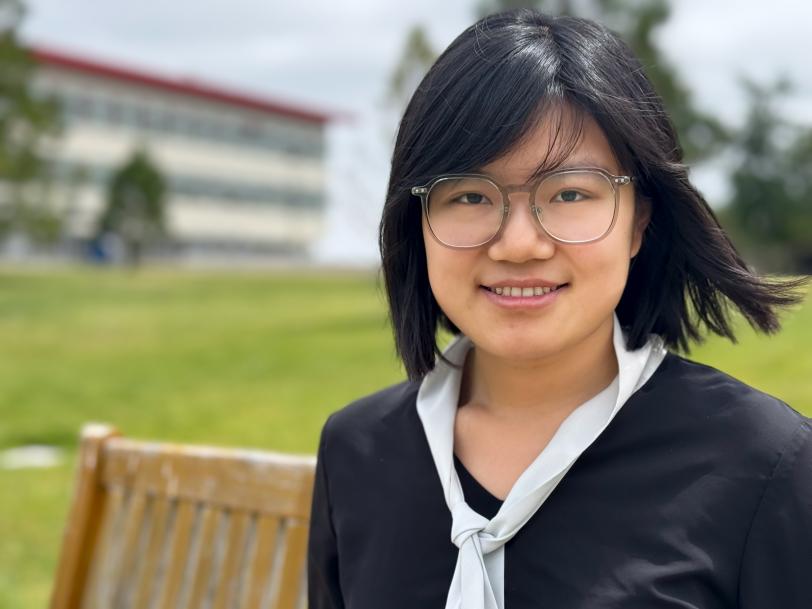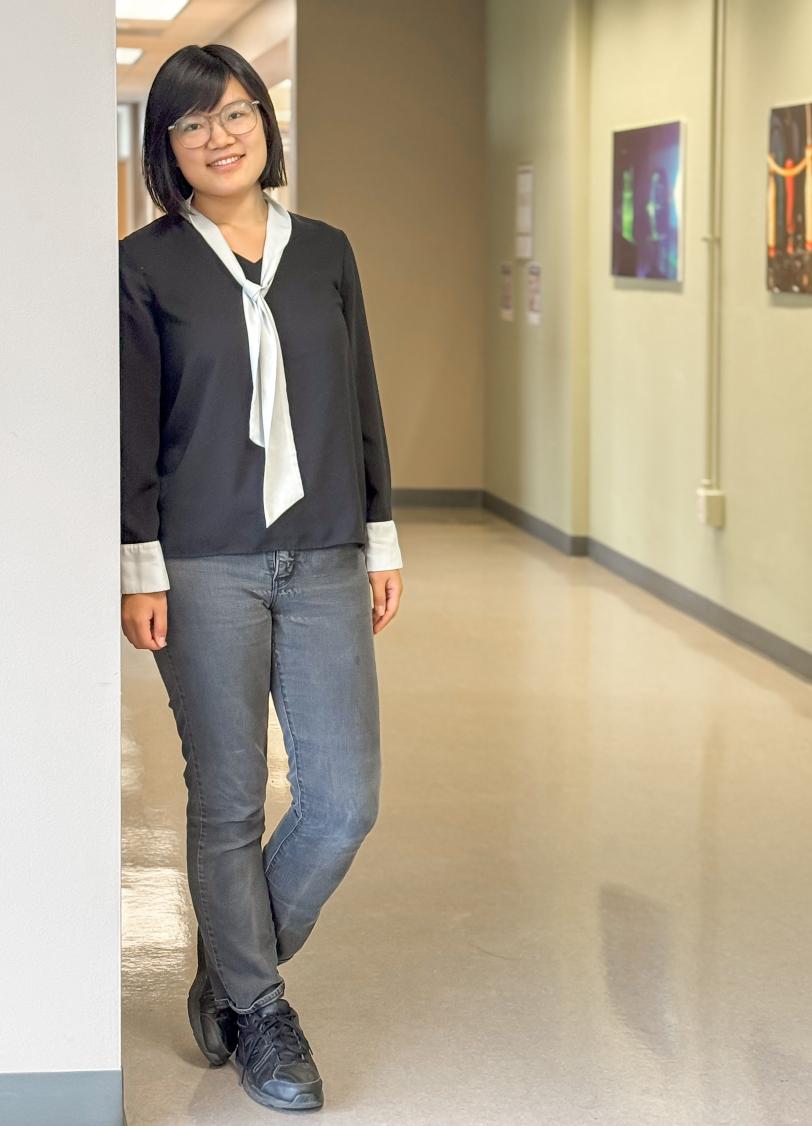2024 SLAC Panofsky Fellow Judy Ji pursues new connections in the quantum world
During her fellowship she will continue research that aims to deepen our understanding of quantum materials.
Zhurun (Judy) Ji has been named the Department of Energy’s SLAC National Accelerator Laboratory’s 2024 Panofsky Fellow. Ji will team up with SLAC and Stanford University researchers to advance studies of exotic, topological states of matter in quantum materials. She will also use her passion for interdisciplinary science to pursue unconventional collaborations with scientists from other fields – including astrophysics.
The Panofsky Fellowship, named after SLAC's founder and first director Wolfgang K. H. "Pief" Panofsky, recognizes exceptional early-career scientists who would most benefit from the opportunity to do their research at the lab. It provides generous funding for five years of research and an opportunity for continuing appointment at SLAC.
As a postdoctoral Stanford Science Fellow, Ji has been working with Zhi-Xun (Z-X) Shen, the Paul Pigott Professor of Physical Sciences at Stanford and an investigator with the Stanford Institute for Materials and Energy Sciences (SIMES), which is a joint SLAC-Stanford institute, on better understanding topological states of quantum matter whose edges allow electrons to flow with no loss, while their interiors block electron flow. Her hope is that these materials may someday be used in quantum computers. But for now, her research is centered on capturing images of their peculiar edge. The Panofsky Fellowship will allow her to continue work on a new technique to do just that. In addition, she will pursue connections with SLAC researchers from other fields, from astrophysics to X-ray science.
“Judy Ji is a scientific force to be reckoned with, demonstrating extraordinary talent, passion, originality and vision,” Shen said. “She is a fantastic addition to the Panofsky Fellowship program and SLAC’s initiative in interdisciplinary sciences.”
In this Q&A, Ji describes her work, her unconventional path to a career in condensed matter physics and some of the surprising collaborations she is pursuing at the lab.

Tell us a little about your research.
My work relates to a discovery that led to the 1998 Nobel Prize in physics: a new state of matter called the “fractional quantum Hall effect.” The Hall effect, well known among physicists, is used to determine the density of charge in conductors and semi-conductors. In the 1980s it was discovered that in a new form of quantum state, electrons team up to form so-called quasiparticles, with fractional charges. Instead of a single electron charge, quasiparticles may have just one-third of an electron charge.
This state is also topologically ordered, which means its edge is conducting and its interior is insulating in specific materials. The quasiparticle carries very robust memory that is protected by the topology, so there are theoretical proposals of using it for topological quantum computing. There’s been a lot of research exploring new systems that host the fractional quantum Hall effect, but we need to directly visualize how the electrons flow at the edge, which has been challenging.
We’ve recently developed a new technique to do just that. As a postdoc, I've been working on integrating optical access to an experimental tool pioneered in Professor Shen’s group called microwave impedance microscopy. It uses microwaves to shine on a sharp metallic tip. And that tip, when scanning a material, can tell us the local conductivity.
What are your plans for the Panofsky Fellowship?
My plans are twofold. First, I will go deeper into the topic I just described, working with my faculty sponsor Z-X Shen on quantum materials, and SLAC’s Emilio Nanni, who is a collaborator of Q-NEXT and an expert and leader in quantum devices and quantum information, as well as researchers at the DOE Energy Frontier Research Center for quantum sensing and quantum materials (QSQM) and Stanford’s Q-FARM. The idea is to work on quantum sensing for quantum materials – still a new field. We want to build new technologies that help us understand these fractional states, potentially contributing to the future development of a real topological quantum computer. We are very far from that future, but that’s the idea we are pursuing now.
The second part is a little wilder. I’ve been talking to Panofsky Fellow Chelsea Bartram, who is working on detecting dark matter axions. We were talking and found out we are both working on something we use microwaves to detect. In quantum materials, there's a type of quasiparticle also called an axion, and it behaves a lot like the dark matter axion that Chelsea is searching for. We are thinking about potential collaborations around these two particles, and it seems promising. So, I’ll be broadening my scope in working with astrophysicists.
That's something unique about SLAC, there are so many people working in different fields, but it seems like people are very free to collaborate. When I first came to Stanford in 2021, I started talking to Sathya Chitturi, a graduate student at LCLS, and Alexander Petsch, a postdoc at SLAC, and we formed a small team to explore using machine learning to accelerate the experimental read-out from neutron scattering studies that was then published in Nature Communications.

What inspired you to choose a career in physics?
I fell in love with science through a series of meaningful experiences.
One takes me back to elementary school. At the end of summer break after second grade, I still hadn't started on my summer homework. My mom gave me a choice: finish the homework in the remaining days of vacation or skip a few grades and try to catch up. I chose to skip and was placed in fifth grade. This decision brought some unforeseen challenges. I struggled both academically and socially at first. But with persistence and effort, I gradually improved and eventually found my footing. This experience taught me to adapt quickly to challenges.
Later, when it came time to choose a major in college, there was skepticism, including from myself, about whether choosing physics was the right path due to the low number of girls in the department at that time. However, I worked with a professor who granted me full access to the equipment in the shared facility center he was leading. During that time, I felt that I had finally found something I could work long hours on without being distracted by external voices or other interests.
To this day, for me, doing science is still about finding joy in the lab and swiftly adjusting to obstacles. I enjoy exploring the hidden interconnections among different things. For example, my PhD was related to topological states, not only the topology of electrons but the topology of light. Typically, people study one or the other, but I thought, "Why don’t we use topological light to study topological electronic systems?" [Editor’s note: She graduated with a PhD from the University of Pennsylvania at the age of 23. Her team’s work on this method was published in Science in 2020.]
What gets you up in the morning to do your research?
Since the first quantum revolution in the early 1900s, quantum materials research has risen with the trend of quantum mechanics and the discovery of silicon, and so forth. But the question that propels me is, “How can we embrace the second quantum revolution?” – which is about quantum entanglement, quantum information and qubits, a basic unit of quantum information. As a part of this, I want to help revolutionize the studies of quantum materials. We are still a long way from building quantum computers, but that’s also what makes it exciting. We don’t know when it will happen, but we are always on the way.
And in terms of my passion for science, I love interdisciplinary science because it allows me to explore the unknown and connect diverse fields in innovative ways, making every day in the lab an exciting adventure.
Also, doing research, especially through the Panofsky Fellowship, gives me the chance to mentor early-career researchers. As Z-X always told me, education makes a real difference. I've been fortunate to receive an excellent education, and I hope to nurture young scientists in pursuing their dreams in a similar way.
For questions or comments, contact SLAC Strategic Communications & External Affairs at communications@slac.stanford.edu.
About SLAC
SLAC National Accelerator Laboratory explores how the universe works at the biggest, smallest and fastest scales and invents powerful tools used by researchers around the globe. As world leaders in ultrafast science and bold explorers of the physics of the universe, we forge new ground in understanding our origins and building a healthier and more sustainable future. Our discovery and innovation help develop new materials and chemical processes and open unprecedented views of the cosmos and life’s most delicate machinery. Building on more than 60 years of visionary research, we help shape the future by advancing areas such as quantum technology, scientific computing and the development of next-generation accelerators.
SLAC is operated by Stanford University for the U.S. Department of Energy’s Office of Science. The Office of Science is the single largest supporter of basic research in the physical sciences in the United States and is working to address some of the most pressing challenges of our time.





